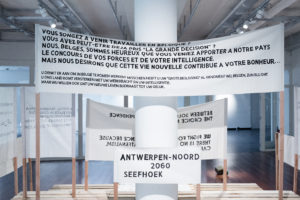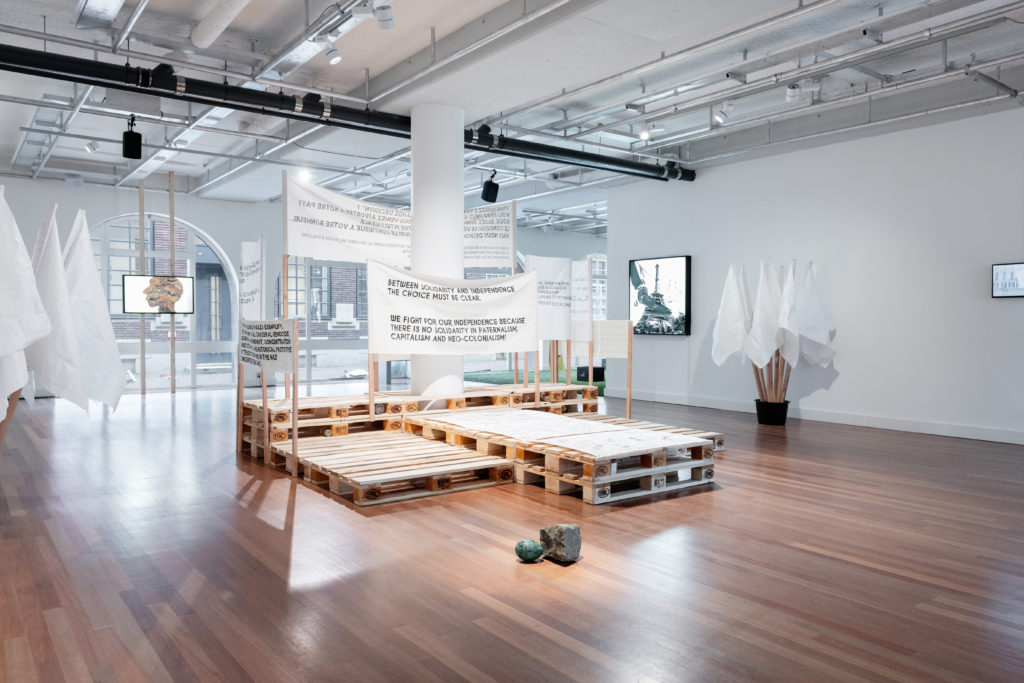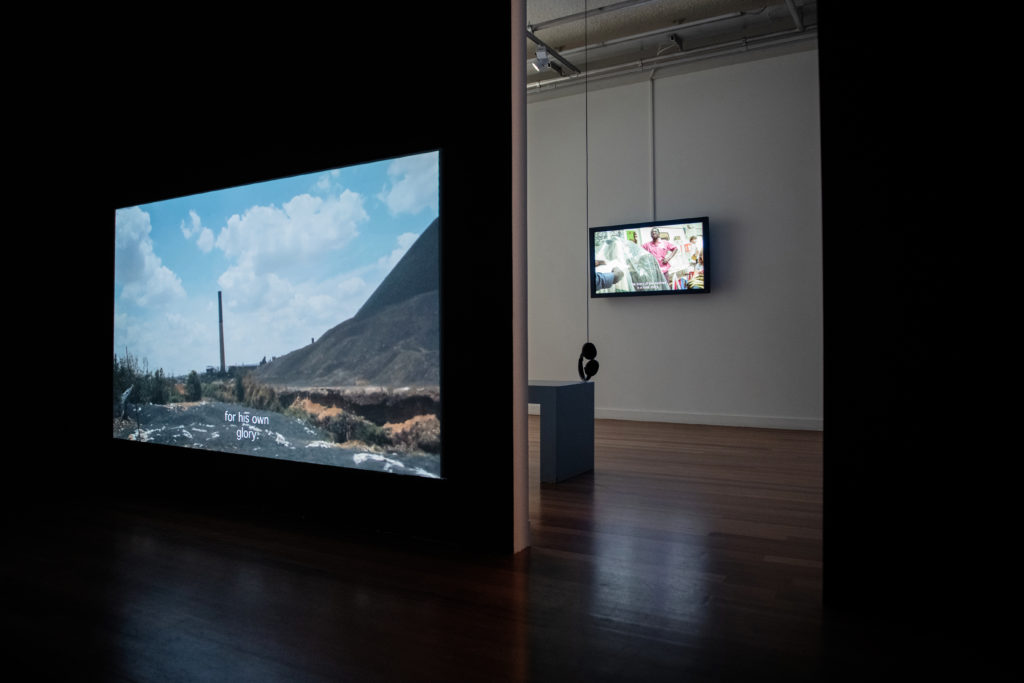
Activism is made to resist, to build and to share awareness and knowledge. Activism is made to implement changes in the collectives and in the society. Take a look at Steve Biko or Winnie and Nelson Mandela, take a look at Fela Kuti, take a look at Martin Luther King or Muhammad Ali, take a look at Franz Fanon or Sarojini Naidu (the only lady standing ahead the Salt March with Gandhi in 1930).
Guy Woueté (1980, Cameroon) in conversation with Rob Perrée
La dernière marché – The last march, multimedia installation, 2017-2020
An interview with Guy Woueté
I create works that give the viewer the possibility to reflect while experiencing a moment in the materiality of space and time
On June 3rd, the WELKOM exhibition by Guy Woueté (1980, born in Cameroon, lives in Brussels) opened in De Brakke Grond in Amsterdam. That was the second opening. Corona ended the first attempt after a few days, a few months ago. Since I have been following his work for years, I was curious about his new project. I had the opportunity to admire his work in March, but there was no time for an interview anymore. Because we couldn’t see into the future because of Corona’s whims, we decided to do an email interview instead. The re-opening of WELKOM makes this interview topical again.

Do you think an artist has to be ‘engagé’?
No. I think that an artist should be aware and open to his/her time. I am very fascinated by the capacity that some artists (Meschac Gaba, Otobong Nkanga, Pascale Marthine Tayou, Barbara Kruger, Jean-Michel Basquiat) have/had to raise questions, build awareness through their working processes and medium. For me, if an artist is able to propose other types of narratives that goes beyond borders, that can reshape or dismiss some traditions, history and conventions, then he/she is “engagé”.

Detail State of Nations, multimedia, installation, 2010-2020
Can I say that the conference of Berlin (1884-1885), where the European superpowers divided Africa, is the ultimate source of your work?
No, you can’t say that. Unless you don’t know the history of the Atlantic slave trade and colonization. You should consider the Berlin Conference as the nearest door to enter the history of colonization and capitalism in my work. As an artist who uses history as aesthetical material, my intention is not to replace historian’s or get my audience lost into the references. I create works that give the viewer the possibility to reflect while experiencing a moment in the materiality of space and time. If someone comes across the Berlin Conference through my work and decides to dig deeper, he/she might find out that the Berlin Conference wasn’t the first attempt by the western Christian world to divide and conquer lands and cultures from which they knew nothing. Take a look at the “Inter Caetera” the papal bull issued by Pope Alexander VI in May 1493 (1) or read the “Codes Noirs” (2) issued by Louis XIV in 1685. That’s where you’ll find the roots of colonialism, white supremacy and racism.
Was the Jungle of Calais exemplary for the way the West deals with migration?
Calais Jungle (3) was the immersed part of the iceberg of the immigration tragedy in Europe. In the Calais Jungle, human rights meant nothing. It’s a place where people have experienced the pinnacle of the institutional violence that results from the European anti-migrant policies and laws.
In 2016 I took a road trip to Calais right before the dismantlement of the migrant’s camp. In Calais, I recorded moments and situations of my life without asking myself what I was going to do with it afterwards and without knowing what was the destination of the 8000 asylum seekers around me. Although I could still see and experience moments of humbleness, love and solidarity, what I saw in Calais Jungle was the Wretched of the Earth (4) caught in Darwin’s Survival of the Fittest.
Trapped in the movement of the Jungle between the migrants, the volunteers, NGOs, the journalists and the assaults by police, not knowing what else I could do apart from being the witness and the living memory of events, I have felt shame of the political rulers of the western democracies. I have felt shame of the African governments who doesn’t value the life of their population. I have felt shame in front of the destructive forces of capitalism and neoliberalism how made such things possible.
Without any possible distinction, in the Jungle and the streets of Calais, I was an assigned illegal migrant. My presence and the color of my skin inscribed me in the stereotype and the assignment: Black = illegal migrant? So my companions in misfortune and I, faced with the imbroglio of our destinies, put in abyss the ideal of the United Nations in article 1 of its Universal Declaration of Human Rights (All human beings are born free and equal in dignity and rights. They are endowed with reason and conscience and should act towards one another in a spirit of brotherhood).
Two years after my return from Calais, in 2018, I was able to transform part of the materials that I brought back into an artist book on migration with the title “Timing Anonymity”. This artist book exists only in 3 copies and I am still looking for a publisher to do a larger publication in order to make this history accessible. I also hope that in the future I will have a possibility to show my Calais experience in an exhibition that will give a tridimensional view to the audience.

Tutankhamun’s chocolate head, 2015

La dernière marché – The last march,multimedia installation, 2017-2020
In what way are you re-writing history?
Re-writing history for me is all about the movement of oneself in the collective. It’s a process of reclaiming your humanity in a freedom act of unlearning. My way of re-writing history is to create and dust off some great forms, ideas, and knowledges that can help amplify the voice of the voiceless and tell the beautiful paradox of the living.
In your videos you always make the ‘audience’ part of your work. Why is that so important for you?
It’s because as a human being I am very much attached to the collective/family. I hold it dear.
But as you know, the perfect family doesn’t exist. You have to make it yourself and that’s what I try to do by making the audience part of my work.
My visual and aesthetic quest is based on my memories and daily experience in/out of the collectives. There are different forms of collectives and we are always at the border, sometimes trying to get out and sometimes trying to get in. For a family or collective the key point is movement. We should always activate and keep the wave of the free movement in order to enjoy and protect the energy flow of each other.

State of Nations, multimedia installation, 2010-2020
Is presenting your work in a gallery or museum not killing the activist character of your work?
Not at all. In galleries and museums my work find a space to open a dialogue with (and connect with) different audiences. Activism has nothing to do with exclusion or destruction of the others. I understand activism as an arm of massive construction. Activism is made to dismiss certain forms of social pathologies (racism, discrimination, sexism, political amnesia …) that block the movement of the individual or the collective. Activism is made to resist, to build and to share awareness and knowledge. Activism is made to implement changes in the collectives and in the society. Take a look at Steve Biko or Winnie and Nelson Mandela, take a look at Fela Kuti, take a look at Martin Luther King or Muhammad Ali, take a look at Franz Fanon or Sarojini Naidu (the only lady standing ahead the Salt March with Gandhi in 1930).
You can call your work conceptual. Is it a challenge for you to visualize the concept? I ask it because you tend to use many media to express yourself.
The use of different media to express myself has nothing to do with visualizing the concept. The concept is everywhere. The thing is to find out how to disentangle what we call the concept by creating a sign, a form, etc., that can speak to people.

Installation view De Brakke Grond, 2020
In what way does the location where you present it influences (the content of) your work?
The location can only have an influence on the content of my work if the work is site specific. This means, if the work has been created from the history, the material or physicality of the location. Otherwise when I’m invited to show my work on a location, the content of the work doesn’t change. But in the display of the works I always try to enter a dialogue or to build a kind of relationship with the space and its energy.
Is the process of developing a work more important to you than the final result?
I don’t think so. The process of developing a work is the difficult part of it. It’s very challenging and yet exciting and enjoyable. Sometime I get lost in research/experiment and the first intuition disappears completely and transforms into something else far from what I have first imagined.
I also enjoy looking at the result with a bit of distance from the process. This is also a very important moment where I can be surprised or disappointed by the results.

Woueté’s Argot, 2020
Is your work ongoing?
Yes my work is ongoing, because my life is a permanent movement of ideas, of people and things. They are not static. In this ongoing process, concept forms and ideas are raw materials that need to be manufactured, transformed and recycled. That’s why from one exhibition to the other you will find out that a drawing has become a collage, an installation has collapsed into a single sculpture, a spoken sentence in a video has detached to become a text silkscreened on a recycled mirror or piece of wood, etc.
Does the Coronacrisis influence your work?
I think that everyone no matter your domain or social class has been affected by the corona crisis crisis. I don’t know yet what the influence of this crisis will be on my work but I’m already sure that the after-corona crisis will be big? For everyone. At the moment, I am facing it and I don’t know how it is going to enter my work. Some questions that are already present in my works (social justice, otherness, solidarity and immigration) have come to the front line in the public debate within the covid-19 crisis and I am happy about that.

Still from Le Fou Postcolonial Insane, 2019-2020
You have studied at the Rijks Academy in Amsterdam. In what way did that influence your work?
Being at the Rijksakademie for 2 years was an incredible experience. It really brought me a lot in my work. I had the opportunity to share and confront my working process with the process of more than 40 other artists from different nationalities, working in different mediums. I also had the technical, the research and the financial facilities to dive deeper in research and experimentations. These were the things I needed in order to develop at that moment.
In what way living in Belgium influenced your work?
I think that living in Belgium has an influence on my work because the social organization here is completely different from what I’ve been used to in Cameroon. In Belgium the medical system is ok. The school system works well although the curriculum should be updated in order to reflect the diversity of the Belgium population today. The colonial history/heritage of the country should be taught without taboo from the primary school and on. The public infrastructure isn’t so bad. I am happy to know that my train is on time when I leaf home in the morning. These basic things make a difference in the way I inhabit Belgium. But there is also the institutional violence and discrimination towards migrants and some minorities in this kingdom. Although you might think you have the freedom of speech in Belgium, you should always remember that claiming whatever you want to claim is at your own risk. And sometimes people claim/go on strike and the officials sent the police (like in Cameroon) or the parliament just votes as if nothing has happened. They say is that is democracy and I say it is bullshit!
The relation to the other is more complex here. The fight between the Walloons and the Flemings is a kind of “tribalism”, exactly like in Cameroon where you have the Duala, the Boulu or the Bamiléké fighting each other.

You are teaching now. Of course money is a reason, but what more does it bring/ give you?
Teaching for me is a lovely experience especially when I have students that are motivated and curious. The Ecole de Recherche Graphique (Erg) (5) where I teach in Brussels is an open space for research and transdisciplinary practices. It’s a place where the students and the professors are free to take initiatives and contribute collectively in the pedagogy project of the school. So far it’s a pleasure meeting my students because I enjoy moments of exchanges with these young minds full of complexities. It’s refreshing me to hear their point of view about the contemporary art world and to see how it affects their works.
